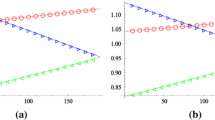Abstract
A usual argument in finance refers to no arbitrage opportunities for the positivity of the bid-ask spread. Here we follow the decision theory approach and show that if positivity of the bid-ask spread is identified with strong risk aversion for an expected utility market-maker, this is no longer true for a rank-dependent expected utility one. For such a decision-maker only a very weak form of risk aversion is required, a result which seems more in accordance with his actual behavior. We conclude by showing that the no-trade interval result of Dow and Werlang (1992a) remains valid for a rank-dependent expected utility market-maker merely exhibiting this weak form of risk aversion.
Similar content being viewed by others
References
Abouda, M. (1999), Buying and selling prices: a characterization of positivity of the bid-selling spread. Cahiers de la M.S.E. 1999 58.
Abouda, M. and Chateauneuf, A. (1997), Symmetrical monotone risk aversion and positive bid-ask spreads. Extended abstract presented at the 8th international conference on the foundations and applications of utility, risk and decision the-ory, Mons (Belgium), July 2- 5, 1997. Beliefs, Interactions and Preferences in Decision Making. Machina & Munier (Eds), Kluwer, Dordrecht, August 1999.
Abouda, M. and Chateauneuf, A. (1999), A characterization of the symmetrical monotone risk aversion in the RDEU model. Cahiers de la M.S.E. 87.
Allais, M. (1953), Le comportement de l'homme rationnel devant le risque: critique des postulats et axiomes de l'école américaine. Econometrica 21: 503–546.
Allais, M. (1988), The general theory of random choices in relation to the in-variant cardinal utility function and the specific probability function. In: B.R. Munier (ed.), Risk, Decision and rationality, pp.233–289. Dordrecht: Reidel.
Amihud, Y. and Mendelsopn, H. (1980), Dealership market: market making with inventory. Journal of Financial Economics 8: 31–53.
Arrow, K.J. (1965), The theory of risk aversion. Aspects of the Theory of Risk Bearing, Chapter 2. Helsinki: Yrjo Jahnsonin, Sastio.
Biais, B. (1993), Price formation and equilibrium liquidity in fragmented and centralized markets. Journal of Finance 48:157–185.
Bickel, P.J. and Lehmann, E.L. (1979), Descriptive statistics for nonparametric models, IV. Spread. In: Jureckova (ed.), Contributions to Statistics. Dordrecht: Reidel.
Chateauneuf, A. (1991), On the use of capacities in modeling uncertainty aversion and risk aversion. Journal of Mathematical Economics 20:343–369.
Chateauneuf, A. (1999), Comonotonicity axioms and rank-dependent expected utility theory for arbitrary consequences. Journal of Mathematical Economics 32: 21–45.
Chateauneuf, A. and Cohen, M.D. (1994), Risk-seeking with diminishing mar-ginal utility in a non-expected utility model. Journal of Risk and Uncertainty 9: 77–91.
Chateauneuf, A., Cohen, M.D. and Meilijson, I. (1997a), New tools to better model behavior under risk and uncertainty: An overview. Finance 18: 25–46.
Chateauneuf, A., Kast, R. and Lapied, A. (1996), Choquet pricing for financial markets. Mathematical Finance 6:323–330.
Chew, S., Karni, E. and Safra, Z. (1987), Risk aversion in the theory of expected utility with rank dependent preferences. Journal of Economic Theory 42:370–381.
Choquet, G. (1953), Théorie des capacities. Annales de l'Institut Fourier (Gren-oble) V,131–295.
Cohen, M.D. (1995), Risk aversion concepts in expected and non-expected utility models. The Geneva Papers on Risk and Insurance Theory 20: 73–91.
Courtault, J.M. and Gayant, J.P. (1999), Disponibilité à payer et disponibilité à recevoir d'un teneur de marché. Cahiers de Recherche du GAINS 99.02.
Dow, J. and Werlang, S. (1992a), Uncertainty aversion, risk aversion, and the optimal choice of portfolio. Econometrica 60:197–204.
Dow, J. and Werlang, S. (1992b), Excess volatility of stock prices and Knightian uncertainty. European Economic Review 36:631–638.
Eeckhoudt, L. and Gollier, C. (1992), Les Risques financiers, Ediscience Interna-tional.
Eeckhoudt, L. and Roger, P. (1994), Partage de Risque et Création de Valeur ajoutée. Revue Économique 45: 5–19.
Eeckhoudt, L. and Roger, P. (1998a), Valuer ajoutée d'un transfert de risque et optimum de Pareto. Revue Économique 49:325–333.
Eeckhoudt, L. and Roger, P. (1998b), Risk aversion and the bid-ask spread. European Financial Management, Forthcoming.
Jensen (1967), An introduction to Bernouillan utility theory: (I) Utility function. Swedish Journal of Economics 69:163–183.
Kast, R. and Lapied, A. (1996), Discrete time generalized option pricing with bid-ask spreads. Mimeo GREQAM.
Landsberger, M. and Meilijson, I. (1994), Comonotone allocations, Bickel- Lehmann dispersion and the Arrow-Pratt measure of risk aversion. Annals of Operations Research 52: 97–106.
La Vallée, I. (1968), On cash equivalence and information evaluation in de-cision and uncertainty, part I, II and III. Journal of The American Statistical Association 63:252–290.
Quiggin, J. (1982), A theory of anticipated utility. Journal of Economic Behavior and Organization 3:323–343.
Quiggin, J. (1991), Comparative Statics for rank-dependent expected utility theory. Journal of Risk and Uncertainty 4:339–350.
Roger, P. (1998), Properties of bid-ask spread in RDEU model. Working Paper.
Rothschild, M. and Stiglitz, J. (1970), Increasing risk: I. A definition. Journal of Economic theory 2:225–243.
Sarin, R. and Wakker, P.P. (1992), A simple axiomatization of nonadditive expected utility. Econometrica 60:1255–1272.
Schmeidler, D. (1989), Subjective probability and expected utility without ad-ditivity. Econometrica, 57:571–587. First version: Subjective expected utility without additivity, Forder Institute Working Paper (1982).
Wakker, P.P. (1990a), Characterizing optimism and pessimism directly through comonotonicity. Journal of Economic Theory 52:453–463.
Wakker, P.P. (1990b), Under Stochastic Dominance Choque-Expected Utility and Anticipated Utility are Identical. Theory and Decision, 29:119–132.
von Neumann, J. and Morgenstern, (1947), Theory of Games and Economic Behavior. Princeton University Press, Princeton, NJ.
Yaari, M.E. (1987), The dual theory of choice under risk. Econometrica 55: 95–115.
Author information
Authors and Affiliations
Rights and permissions
About this article
Cite this article
Abouda, M., Chateauneuf, A. Positivity of bid-ask spreads and symmetrical monotone risk aversion* . Theory and Decision 52, 149–170 (2002). https://doi.org/10.1023/A:1015560016516
Issue Date:
DOI: https://doi.org/10.1023/A:1015560016516




